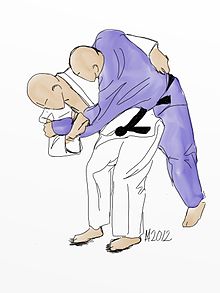
Judo is an unarmed modern Japanese martial art, Olympic sport, and the most prominent form of jacket wrestling competed internationally. Judo was created in 1882 by Kanō Jigorō as an eclectic martial art, distinguishing itself from its predecessors due to an emphasis on "randori" instead of "kata" alongside its removal of striking and weapon training elements. Judo rose to prominence for its dominance over established jujutsu schools in tournaments hosted by the Tokyo Metropolitan Police Department, resulting in its adoption as the department's primary martial art. A judo practitioner is called a "judoka", and the judo uniform is called "judogi".
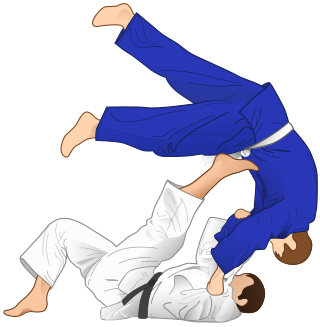
Nage-no-kata is one of the two randori-no-kata of Kodokan Judo. It is intended as an illustration of the various concepts of nage-waza that exist in judo, and is used both as a training method and as a demonstration of understanding.
Tenjin Shinyo-ryu, meaning "Divine True Willow School", can be classified as a traditional school (koryū) of jujutsu. It was founded by Iso Mataemon Ryūkansai Minamoto no Masatari (磯又右衛門柳関斎源正足) in the 1830s. Its syllabus comprises atemi-waza, nage-waza, torae-waza, and shime-waza. Once a very popular jujutsu system in Japan, among the famous students who studied the art were Kanō Jigorō, whose modern art of judo was greatly inspired by the Tenjin Shin'yō-ryū and Kitō-ryū, or Morihei Ueshiba, who later founded aikido.
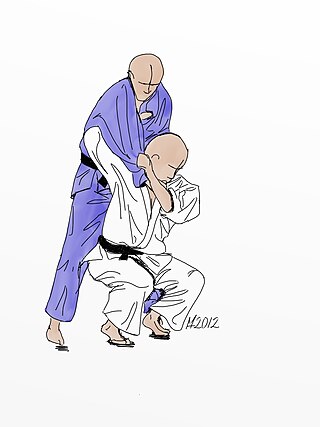
Seoi nage is a throw in judo. It is one of the traditional forty throws of judo as developed by Jigoro Kano. It belongs to the first group, Dai Ikkyo, of the traditional throwing list, Gokyo, of Kodokan Judo. It is also part of the current official throws of Kodokan Judo. It is classified as a hand technique, te-waza, and is the second throw performed in the Nage-no-kata. Seoi nage literally means "over the back throw", but has also been translated as a "shoulder throw", as the opponent or uke is thrown over the thrower or tori's shoulder.

Deashi Harai (出足払), more accurately romanized: Deashibarai, is one of the original 40 throws of Judo as developed by Jigoro Kano. It belongs to the first group, Dai-Ikkyo, of the traditional throwing list, Gokyo-no-Nagewaza, of Kodokan Judo. It is also part of the current 67 Throws of Kodokan Judo. It is classified as a foot technique, Ashi-Waza. Deashi Harai is also one of the 20 techniques in Danzan Ryu's (DZR) Nagete list.

Uki Goshi (浮腰) is one of the original 40 throws of Judo as developed by Jigoro Kano. It belongs to the first group, Dai Ikkyo, of the traditional throwing list, Gokyo, of Kodokan Judo. It is also part of the current 67 Throws of Kodokan Judo. It is classified as a hip technique, Koshi-Waza. Uki goshi is known as a favorite throw of Jigoro Kano himself. It is demonstrated in the Nage no Kata. It used to be much drilled in traditional judo dojos.

Ōuchi gari (大内刈) is one of the original 40 throws of Judo as developed by Kanō Jigorō. It belongs to the first group, Dai Ikkyo, of the traditional throwing list, Gokyo, of Kodokan Judo. It is also included in the current 67 Throws of Kodokan Judo. It is classified as a foot technique, Ashi-Waza.
Yama Arashi is one of the preserved throwing techniques, Habukareta Waza, of Judo. It belonged to the fifth group, Dai Gokyo, of the 1895 Gokyo no Waza lists. It is categorized as a hand throwing technique, Te-waza. It rarely occurs in competition or randori.

Ushiro Goshi (後腰), is one of the original 40 throws of Judo as developed by Jigoro Kano. It belongs to the fifth group, Gokyo, of the traditional throwing list, Gokyo-no-Nagewaza, of Kodokan Judo. It is also part of the current 67 Throws of Kodokan Judo.

Tsurikomi Goshi (釣込腰), is one of the original 40 throws of Judo as developed by Jigoro Kano. It belongs to the second group, Dai Nikyo, of the traditional throwing list, Gokyo, of Kodokan Judo. It is also part of the current 67 Throws of Kodokan Judo. It is classified as a hip throwing technique, Koshi-Waza. Tsurikomi Goshi is also one of the 20 techniques in Danzan Ryu's Nage No Te list.

Uki otoshi (浮落), or "floating drop," is one of the traditional forty throws of Judo as developed by Jigoro Kano. It belongs to the fourth group, Dai Yonkyo, of the traditional throwing list, Gokyo-no-Nagewaza, of Kodokan Judo. It is also part of the current 67 Throws of Kodokan Judo. The technique is categorized as a hand technique, Te-waza.
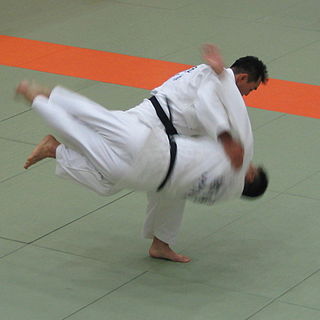
Harai goshi (払腰) is one of the original 40 throws of Judo as developed by Kano Jigoro. It belongs to the second group of the traditional throwing list in the Gokyo no waza of the Kodokan Judo. It is also part of the current 67 Throws of Kodokan Judo, and classified as a hip technique (koshiwaza). Harai goshi is also one of the 20 techniques in Danzan ryu's Nagete list as well as one of the 18 throws in the Kar-do-Jitsu-Ryu martial arts system. English terms include "Sweeping hip throw" and "Hip Sweep".

Hane goshi is a throw in judo. It is one of the original 40 throws of Judo as developed by Jigoro Kano. It belongs to the third group, Sankyo, of the traditional throwing list, Gokyo, of Kodokan Judo. It is also part of the current 67 Throws of Kodokan Judo. It is classified as a hip technique, Koshi-Waza. Hane goshi is also one of the 20 techniques in Danzan Ryu's Nagete list.

Utsuri Goshi (移腰), or the changing hip throw, is one of the original 40 throws of Judo as developed by Jigoro Kano. It belongs to the fourth group, Yonkyo, of the traditional throwing list, Gokyo-no-Nagewaza, of Kodokan Judo. It is also part of the current 67 Throws of Kodokan Judo. It is classified as a hip technique, Koshi-Waza.
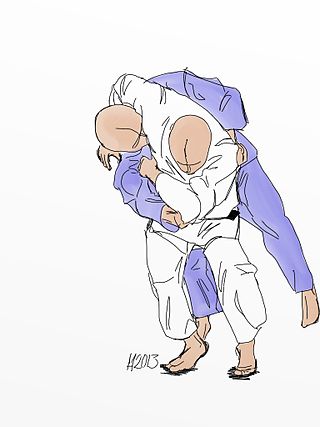
Koshi Guruma (腰車), is one of the original 40 throws of Judo as developed by Jigoro Kano. It belongs to the second group,

Tsuri goshi (釣腰) is one of the original 40 throws of Judo as developed by Kano Jigoro. It belongs to the third group of the traditional throwing list in the Gokyo no waza of the Kodokan Judo. It is also part of the current 67 Throws of Kodokan Judo. It is classified as a hip technique (koshiwaza).

Ashi guruma is a throw in judo. It is one of the original 40 throws of Judo as developed by Kano Jigoro. It belongs to the third group of the traditional throwing list in the Gokyo no waza of the Kodokan Judo. It is also included in the current 67 Throws of Kodokan Judo and is classified as a foot technique (ashiwaza).

Ura Nage (裏投) is one of the original 40 throws of Judo as developed by Jigoro Kano. It belongs to the fifth group, Gokyo, of the traditional throwing list, Gokyo, of Kodokan Judo. It is also part of the current 67 Throws of Kodokan Judo. It is classified as a rear sacrifice technique, Ma-sutemi.

Sode Tsurikomi Goshi (袖釣込腰) is a Judo throw and one of the techniques adopted by the Kodokan into their Shinmeisho No Waza list. It is categorized as a hip technique, or Koshi-waza. Sode Tsurikomi Goshi translates as sleeve lifting pulling hip throw.
